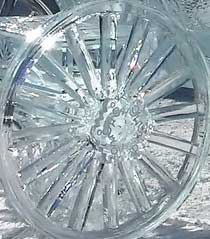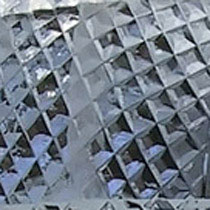


Details of Kevin Gregory and Tony Young’s hand-carved ice carriage for Ottawa’s Winterlüde Festival,
“A Winterlüde Fantasy,” 2003.
Photo credit: Ken Watson
Kevin Gregory and Antonio Young
There is a certain unexplainable fascination that people have with the sculpting of ice. I suppose that same draw got me interested in it. Once I put myself in a position to be able to not only try it, but to do it on a regular basis (at The Balsams Resort) I was hooked. Another alluring quality of it for me is that it is a very fast art and it comes together very quickly. With some smaller carvings coming together in a few hours, or larger projects coming together in a few days, you certainly do not have time to get bored. The art of ice carving, especially competition carving, is very competitive and there is a certain energy that gets into some of us and keeps us looking forward to the next event to try to push the bar a little further.
The ice carriage was created for an event in Ottawa as
part of the Winterlüde celebration. This particular event was called the Masters Event and there were four teams invited to compete. There were teams from Canada; from the United States; from France, and from Japan. It was the 25th annual Winterlüde, so they implemented a theme of 25 into the competition. They did that by supplying each team with twenty-five 20" x 40" x 10" 300 pound blocks of ice and giving each team 25 non-consecutive hours to complete its entry. The title to our entry was “A Winterlüde Fantasy.” The thought process in our selection of design was to connect the mystical and fantasy like qualities of ice sculpture to a tangible fairy tale like subject such as the chariot.
The sculpture was 100% hand carved by me (Kevin Gregory) and Antonio Young. We practiced the design once at our studio outside of Philadelphia, then packed our tools and flew to Ottawa for the weekend.
Standard tools of the trade start with a couple good electric chainsaws, angle grinders (for sanding), die grinders (routers) with various bits, chisels, nailboards, aluminum plates (for bonding ice together). Different ice carvers use blow torches, and other small tools.
Different seams are joined together in different ways. Large seams are usually done with nailboards. These custom tools are a very flat boards with handles on the topside and hundreds of equally placed screws poking through the bottom. The concept is when the board is scraped along each piece of ice to be joined, the screws take away the high spots and leaves the low spots, eventually giving you perfectly level, flat surfaces to bond together with water in between. Another method is to use hot aluminum plates. When a hot aluminum plate is applied to the ice you are left with a perfectly flat surface to bond together with water in between.
We started designing the carriage by sketching it small scale on paper. The design was inspired by a beautiful piece of crystal that I saw at the Waterford factory in Waterford, Ireland when I was on vacation several years ago. Then we determined how large we could make it, given the amount of blocks provided.
The large sphere for the middle was made by cutting several blocks into thirds at certain angles on both top and bottom and sides to equal 360 degrees vertically and horizontally. We used the same mathematics that any other craftsman would use. We then evaluated how this structure would be supported and any other measurements we needed to calculate. We broke all this information down, made it fit into 25 standard size blocks, and carefully mapped it out on paper block by block. The only full sized templates used were for the wheels, the rest or it was by measurements and angle jigs. The carriage has supports that go to the ground inside where the wheels are attached. Texture in carriage body is hand-applied detail done with Japanese ice carving chisels in the shape of a V. (V chisels) Each one of those facets is applied by hand and sighted by eye.
We started with 7,500 lbs of ice. It probably weighed about 6,000 pounds by the time the sculpture was completed. It took 25 hours for our two-man team to complete. The first day, all of the rough blocks were stacked up and frozen together. The second day, the chariot was shaped, detailed inside and out, and the wheels were cut. The third day, the interior bench was installed along with all the other interior components; the wheels and all other ornaments were attached. Then the entire chariot was blow-torched inside and out to make it glisten. There were no molds or small-scale models used.
The weather was good all three days: below freezing, a mixture of sun and clouds, and not snowing or raining. The city of Ottawa is alive with events the entire duration of the festival. Ice sculpture is a very large part of the festival. The week before the masters ice competition is the standard international ice carving event, and all of those sculptures are still up in a huge ice sculpture garden for people to enjoy, then as people walk to the back area the masters event is in progress. There were literally tens of thousands of people though the event throughout the weekend. We enjoyed the experience very much. We sculpt ice for a living and do it for business six days a week/50 weeks a year. When competition season rolls around (January-March) we love to travel and do freestyle competition quality work and potentially win money doing it. The Capital Commission treated us like kings and took great care of all of us.
—Kevin Gregory/Antonio Young Ice Concepts Inc., Philadelphia, PA IceConceptsInc.com…to artists’ bios